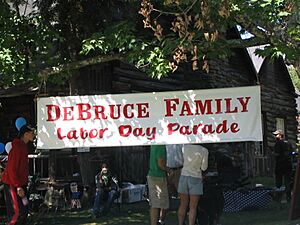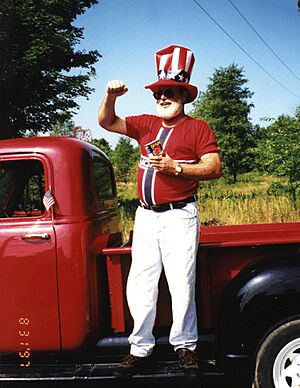Debruce, New York facts for kids
Quick facts for kids
Debruce
|
|
|---|---|
|
Hamlet
|
|
| Country | United States |
| State | New York |
| County | Sullivan |
| Time zone | UTC-5 (Eastern (EST)) |
| • Summer (DST) | UTC-4 (EDT) |
| ZIP codes |
12758
|
| Area code(s) | 845 |
De Bruce is a small community, also known as a hamlet, located in Sullivan County, New York, in the United States. It's a quiet place with a rich history, especially known for its connection to fly fishing and beautiful natural surroundings.
Contents
Where is De Bruce Located?
De Bruce is about 6 miles (10 km) east of Livingston Manor. It's found where two creeks, Willowemoc and Mongaup, meet. You can find it on a map at 41°55' North and 74°44' West.
A Look Back: De Bruce's History
How De Bruce Got Its Name
The name De Bruce comes from Elias DesBrosses. He was a French Huguenot who invested in the New World a long time ago. His family became wealthy landowners in New York.
A Resort Town for Fly Fishing
De Bruce was once a popular vacation spot. It was especially loved by people who enjoyed fly fishing. George LeBranch, a famous author, had his home here. In 1914, he wrote a book called The Dry Fly and Fast Water. He even cast his first dry fly right here in De Bruce!
The De Bruce Club Inn
The De Bruce Club Inn was a very special place. Charles B. Ward first owned it, then Walter Kocher took over in the 1940s. The Inn had a nine-hole golf course and tennis courts. Guests could also fish on miles of the best water on the Willowemoc Creek.
The Inn had its own farm and a fish hatchery. It even had its own power plant and a private phone system. Movies were shown on weekends. In the 1930s and 1940s, it was a favorite spot for sports lovers from the city. It was famous for its delicious food and friendly staff. Chef Cesar Ricci was well-known for his grand outdoor picnics. These picnics had tables, linens, and even whole animals roasted!
Fun Facts from the Past
In the early 1900s, one of George LeBranch's favorite fishing flies was called the "pink lady." It was a pale pink fly with gold tinsel. Interestingly, a popular drink at the Inn was also called the "pink lady." It was a mix of gin, grenadine, apple brandy, and lemon juice. This drink was also popular with parents visiting their children at nearby summer camps.
What Remains Today
The main Inn building was taken down in 1970. However, some parts of the old hotel still stand. These have reopened as The Rose Cottage in De Bruce. The De Bruce Fly Fishing Club now uses what was the Fishermans' Cottage and the fish hatchery. They also lease several miles of the Willowemoc Creek for fishing.
Today, the Kocher family owns and runs several properties. These include The Rose Cottage, a small bed & breakfast. There's also the Swiss Cottage, which is available for rent. The De Bruce Farmstead has gardens and raises chickens and ducks for eggs.
Learning in Nature: De Bruce Camp
The New York State Department of Environmental Conservation (DEC) runs the De Bruce Environmental Education Camp. This camp is for young people aged 12 to 14. It's located on over 300 acres (1.2 km2) of land next to the Catskill Forest Preserve. Camp De Bruce has been helping kids learn about nature since 1948.
It used to be a private estate and fish hatchery. The DEC bought it in the 1940s and turned it into a camp for boys. In 1975, Camp De Bruce became a camp for both boys and girls. Other camps in the area during the Inn's busy years included Camp Acadia and Our Lady of Lourdes Camp for Girls.
The Tannery Industry
In its earliest days, De Bruce was home to one of the biggest tanneries in the Catskills. A tannery is a place where animal hides are turned into leather. This tannery opened in 1856 and employed over 100 men.
The tanneries needed lots of water and hemlock trees. The bark from these trees was used to process the leather. Workers would cut down the trees, peel off the bark, and leave the wood to rot. This industry quickly used up the trees. It was at its busiest around 1870 but was completely gone from the Catskills by 1895. This was probably good news for the trout fishermen! Bald Mountain in De Bruce got its name because the tanneries left it bare.
New Beginnings
In 1985, the De Bruce Country Inn opened near De Bruce. It was later sold and is now known as The De Bruce. The old De Bruce Club Inn has also reopened as The Rose Cottage in De Bruce.
De Bruce Family Labor Day Parade
De Bruce is famous for its "De Bruce Family Labor Day Parade." This parade has been held every year since 1993. It brings the whole community together to celebrate the end of summer and the autumn harvest.
Steve Dill (pictured) was the main organizer of the parade. He would get his friends and neighbors excited for a day of speeches, face-painting, dancing, games, food, and costumes. Sometimes, there was even a King or Queen of the parade. Floyd Cook, who was 100 years old and known as the "Mayor of the Hill," had this honor several times. Sadly, Mr. Cook passed away in 2012.
One fun fact about the parade is how short it is! It starts in Steve Dill's front yard and goes for about one city block. This is much shorter than the long line of marchers and vehicles in the parade!
In 2007, the parade had a "green" theme. Two aircraft even flew over the parade! The parade didn't happen in 2009, but it came back in 2010 with the theme "Books, Bubbles and Balloons." In 2011, the theme was "Fun, Food, and Fitness." In 2012, it was "Cars, Crafts, and Country." The 2012 parade had the biggest turnout ever. There were 50 antique cars, many groups and businesses, a firetruck, and the MountainTones marching band. This band actually started at the De Bruce parade!
After 2010, the De Bruce parade became a fundraiser for the Livingston Manor Free Library. This library is about 6 miles away from the parade site. The De Bruce Parade stopped when its organizers moved away.
Notable People
- Charles B. Ward, a former US Congressman




